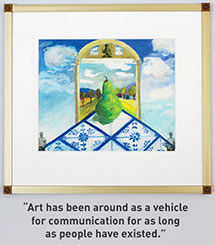The Healing Arts
Springfield College Art Therapy Program Director Simone Alter-Muri
Springfield College Art Therapy Program Director Simone Alter-Muri
Professor Simone Alter-Muri’s groundbreaking research on children’s art is just one facet of a life dedicated to understanding — and practicing — creativity.

Early in her career, Springfield College Art Therapy Program Director Simone Alter-Muri ran an after-school arts class in Northampton, Mass. In a big barn on her home property, children would gather in the afternoons to draw, paint, craft, and sculpt. She recalls one little boy who was particularly eager.“I would come home and he would already be waiting outside,” the founder of Springfield’s art therapy program says, “saying ‘I want to do art!’”She laughs when she tells the story, and it’s clear that she knows how he felt. She has wanted to do art for as long as she can remember, and it has become the thread running through her life and professional career. As a therapist, a teacher, a researcher, and an artist herself, Alter-Muri has made human creativity an essential pursuit.
“I want to make a difference in the world by inspiring and teaching students to assist people in our communities to experience the healing and therapeutic potentials of art,” she says. “Through visual means, through teaching, and through the collection of data. Art can be a vehicle for knowledge, personal growth, and healing. I want to make people more aware.”
Alter-Muri’s work reached a wider audience recently when a study that she co-authored with alumna Stephanie Vazzano ’20 garnered the attention of the Wall Street Journal. Published in the April 2014 edition of the peer-reviewed journal The Arts in Psychotherapy, Alter-Muri’s study on gender typicality in children’s art examines images in children’s drawings from around the world to help parents, educators, and psychologists understand what is typical in children’s art across cultures. Her work studies the inclusion of various subjects — vehicles, weapons, animals, sports, and others — in art by six-to-11-year-olds, providing new data on the frequency of each in boys’ and girls’ art, and challenging some long-held beliefs about “normal” stages of art development.

“The goal of my research and my students’ research is to help gain an understanding of what is typical,” Alter-Muri says. “If you don’t know what’s typical, how do you know what’s not typical or what might be a problem? We want to define a baseline.”
Children’s art is often used by parents, teachers, and psychologists to assess children’s development and mental health. Alter-Muri believes that there is a gap in the research about what is typical, making it difficult to assess real problems with confidence.
“We often come from a medical model and we tend to see what’s wrong — the problems, rather than the strengths,” she says. “It is important to look at what is typical, rather than only at what might be pathological.”
The seminal study on the subject, and still the most widely used text in art education, Viktor Lowenfeld’s Creative and Mental Growth, was first published in 1947, and updated by William Brittain in 1964. Alter-Muri reveres the work as foundational in her field, but she also believes that the environment in which children create art has changed.
“Lowenfeld, like all theorists, was a product of his time,” she says. “When he was collecting data, we didn’t have television or cell phones or computers like we do today. Children are seeing symbols all over the place, and when you’re seeing all these images, it will affect your drawing. One thing we found in the study was that certain stages of development seemed to be starting at a slightly higher age. The stages may have shifted.”Other findings: More girls than boys placed images on a baseline, and boys put more vehicles in their art. Girls used more color than boys, and boys tended to use less color as they grew older. Across cultures, both boys and girls liked to draw images of sports.“We have some myths,” Alter-Muri says. “That boys are more aggressive, or that girls draw flowers. I’d like to see what is typical so that we can dispel any myths that even well-meaning people might have.”Although Alter-Muri regards her research with the dispassionate eye of a social scientist, her interest in children’s art is closely connected to her own creative work.
“Children’s art is honored by many artists,” she says. “Picasso collected children’s art. Paul Klee collected children’s art. In a way, children are much more free than adults. I think adults sometimes look at that with envy. There’s a freedom and spontaneity there.”
Alter-Muri’s interest in art started early. She grew up in the Bronx, doing projects with her mother, who taught English and art at a public junior high school in New York. Before she brought activities to her students, Alter-Muri’s mother would try them out on her daughter, who came to love working in various media.
Alter-Muri continued to make art in high school and college. As an undergraduate at the University of Massachusetts Boston, she studied studio art and psychology, but as separate disciplines. “At the time,” she says, “there were no majors in art therapy.”
She earned a Master of Education from Lesley College (now Lesley University), and a Doctor of Education in child development and creative behavior at the University of Massachusetts Amherst, which included research in methodology and pedagogy, teaching preschool teachers how to teach art more creatively. She also worked with people with severe developmental disabilities, in a program on the grounds of the Danvers State Hospital.
“Their art was just scribbles, but I became interested in it,” she says. “It was interesting to me that no matter how disabled a person was, they could create.”
When one of her supervisors told her about an organization down the street called Art to People, Alter-Muri applied, and eventually became the organization’s director. “I was teaching art to all kinds of people,” she says, “And hiring educators and artists to do it. We were teaching to elders, to children, to people in jail.”
In 1987, Alter-Muri joined Springfield College as an adjunct professor, helping Professor William Blizard coordinate the work of students teaching art in prisons and other community-service settings. When Blizard invited her to design an art-therapy class, she jumped at the opportunity — and quickly realized that her students needed a program that would give them comprehensive preparation for their work in the community. Gradually she was able to implement and expand first the undergraduate and then the graduate art-therapy programs at Springfield. Along the way, she has become a full professor, with an office in the heart of the art department in Blake Hall.
“At Springfield,” Alter-Muri says, “we have this amazing space in which to create art, and in which to encourage others to do art.”
Alter-Muri’s own creative work ranges widely, from plein air paintings in oil to massive installations featuring images of bar codes. Each, she says, plays a different role.
“With plein air,” she says, “I’m actually out in the landscape, being in the moment, which has to do with mindfulness, flow, and creativity.” Her barcode installations, on the other hand, are intended to challenge the viewer. “Barcodes are overlooked, and yet they are all around us, legitimizing depersonalization. Everything has a barcode on it now, and it’s very much accepted and nobody questions it or looks at it. But if you change one number on a bar code, it changes the whole thing. I’m interested in how easily data can be manipulated. It can be helpful, but it can also cause problems.”
Alter-Muri has created art related to genocide, the Holocaust, and the environment. “What my work has led me to understand,” she says, “is how important art is to people all over the world, how important it is to create, to make a mark.”
Few, perhaps, will find as many ways to do that — and to help others do that — as Alter-Muri has.
In the course of her research, she has collected more than 1,000 pieces of children’s art from more than 14 countries. She plans to expand that collection, and hopes that the works at Springfield College can become an archive and a destination for other researchers seeking to learn more about children’s art and development. She is currently studying the relationship between tattoos and symbols, and presented her latest findings on children’s art development in March at the National Art Education Association conference in New Orleans.
“Art has been around as a vehicle for communication for as long as people have existed,” she says. “Art connects us to the inner language of the heart, and it also wakes us up. When we don’t pay attention, we can miss what’s happening in the world. I want people to pay attention.”




